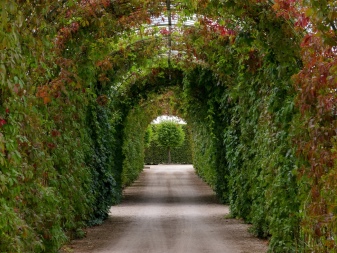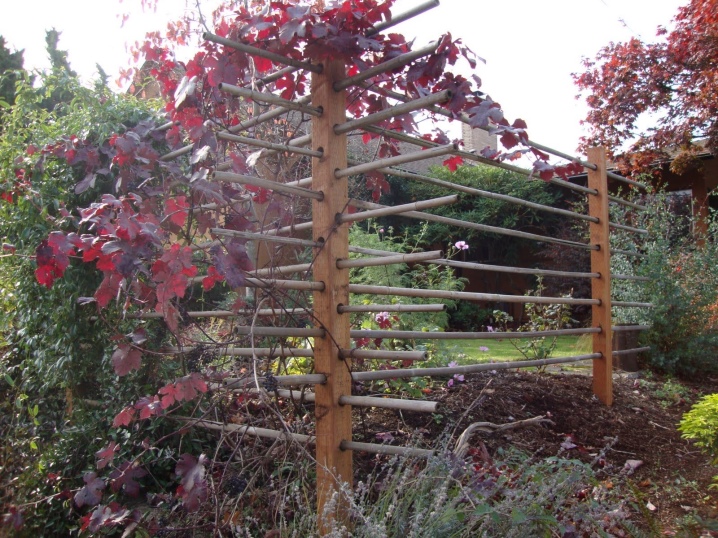Support for maiden grapes

A garden without vines, without climbing ornamental deciduous and flowering plants seems boring. Such a garden lacks an aura of mystery, half-concealment, understatement and uniqueness. This is what vines can provide - annual or perennial.


Peculiarities
If the decision is made to decorate the site with liana-like plants, to make it more colorful and attractive, then one of the best perennial deciduous lianas for this purpose can be safely considered the Maiden Grape. All the charm of this species lies in its lush crown, which has many shades and changes color depending on the season. In addition, the vine is famous for its powerful growth, length and versatility in landscaping. The peculiarity of tri-pointed or five-leaf grapes is its large mass and length, which requires serious support.
Liana-like plants are supported by various adaptations, which in this particular case have the main feature - reliability. The mass of decorative grapes is very large, so a trellis in the form of a thin stretched wire is not suitable here - it will not withstand the weight over time. There are several types of capital supports that ensure the full development of plants.
The support for the Maiden Grape must be massive and strong, forged or made of wood, not counting the walls and fences, which themselves are the basis.



Varieties
When choosing racks for Maiden grapes, one must take into account the place where it will be placed and what exactly is expected from the plant.
Arch
A doorway-like structure with an arcuate curvature at the top. The material of manufacture, shape, height, width and length can have a variety of parameters - it all depends on the place where the arch will be installed. If it is erected on the driveway to the house, then it should be spacious and high so as not to interfere with the free passage and passage of the car. Removable and mobile structures are not used for decorative grapes.


Pergolas
Decorative walk-through canopy with repeating sections of the same type, whose purpose is to support climbing plants. Pergolas are popular for climbing roses, grapes, and other heavy perennials. Made from wood, metal and other materials. Most often they play the role of gazebos. A pergola on a site is an accent in landscape design, therefore, for its construction, you must carefully choose a place, configuration, material. Pagoda-shaped pergolas are very popular.

Obelisk
This type of support looks like a three-, four-sided stele, pyramid, column. The role of the obelisk can be performed by supporting columns at the entrance area. An obelisk is not necessarily a solid structure, it can be openwork made of metal, wooden slats and other things. At the same time, one must remember about the weight of the grapes - the support must be massive. If these are not columns, then the obelisk most often plays a solo role in the center of a flower bed or lawn, it can be part of a lamp post.

Lattice
A universal support, independent or part of a complex structure, for example, a pergola. An ideal solution for zoning a site - with its help, you can select separate corners of the garden, create secluded cozy places, recreation areas with a bench, a spring, a fountain.

Trellis
We can say that this is the same lattice. It can be a solo or part of a garden composition, for example, a support against the wall of a garden pool.

Trellis
A structure that is hardly used as a support for the Maiden Grape. These are pillars with a wire stretched between them. Typically used in fruit vineyards.

Wall, fence
Wall, fence - the most common types of supports for decorative grapes. A wooden, brick, concrete wall is an ideal surface for a tenacious climbing vine. Planting along fences in 2-3 years turns them into a "hedge".


The most original device for landscaping a vine is a creative solution with a lot of imagination. Braided tyn, base for green sculpture, communication pipes and much more.
You can just look around, think about what is hindering, what you want to cover up, “turn on” your imagination - and then a real landscape work will appear in front of your house.


How to tie correctly?
Having decided on the type of support, organizing its device in a permanent place, you can plant young plants. After the shoots begin to grow, it is necessary to tackle the direction of their growth. Of course, if it's a hedge, then let them grow by themselves. If we are talking about a pergola, then the garter of young shoots is required - it is necessary that part of the vines spread along the ground. To do this, young shoots are tied horizontally to the lower bridges. Otherwise, they will immediately "rush" vertically upward, as a result, the bottom will remain empty, since the vine begins to branch and overgrow with foliage about half a meter from the ground.

In the case when the vine should green the wall of the house, the direction of the shoots is set taking into account the location of the windows and doors - near them, the interfering shoots are cut off, tied to the neighboring ones, directing their growth a little to the side.
If the vine is planted in a pot, and its place is on the balcony, then the root can be placed in one corner, and the shoots can be tied up as they grow, directing in the opposite direction. Then they can be run upwards along the perimeter and re-laid horizontally, thus forming a "green canopy". In a similar way, you can lay them beautifully on the terrace, achieving the desired effect.















The comment was sent successfully.